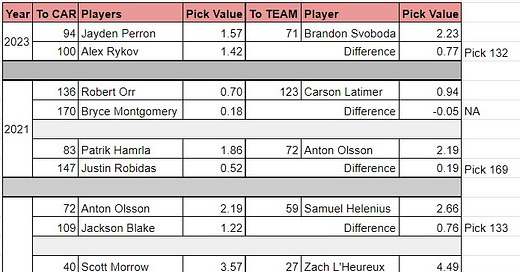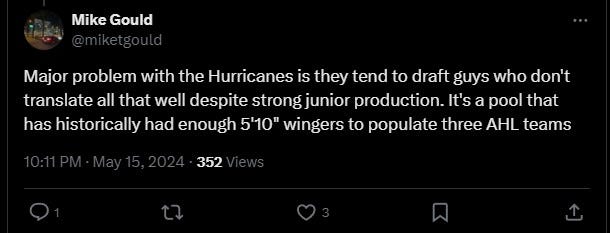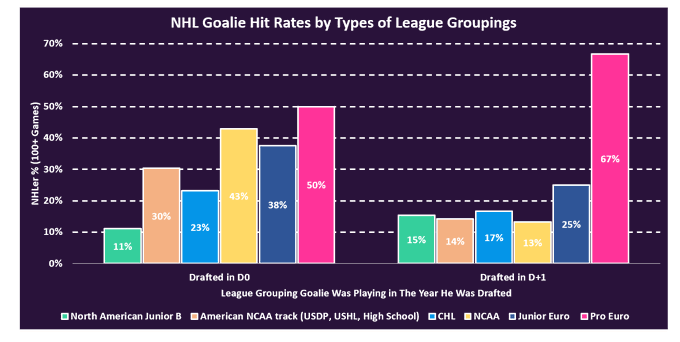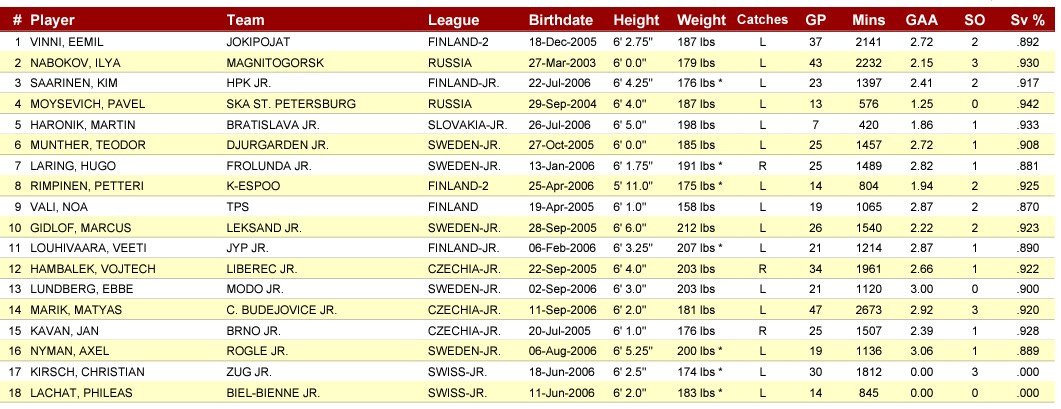Mike Grier's gotta start playing with house money (and three lessons to learn from the Hurricanes' asset management)
#AssetManagement
The Carolina Hurricanes of the past six seasons are doing something few perennial contenders achieve. They manage to compete for a Cup while boasting a strong youth pipeline. If everything works well, the franchise might avoid the sudden crash and burn so familiar to longtime hopefuls like San Jose and Chicago. Carolina has set themselves up for longer-term success by acquiring house money whenever possible, an asset-management design more teams should emulate. With the Macklin Celebrini window all but officially open, Mike Grier would do well to follow in Carolina’s footsteps, starting with the 2024 NHL Entry Draft.
There are three major tenets to Carolina’s strategy.
Leave the draft with more assets than you came with.
Focus on undervalued types of prospect profiles, especially outside the top-15-or-so selections in the draft.
Acquire something in return for prospects you’re pretty sure are not gonna make it (NGMI) and players that don’t fit into your future plans.
Leave the draft wealthier than you were when you entered
Earlier this offseason I looked at whether or not trading up in the NHL draft is a good idea. Please have a gander if you haven’t already. The tl;dr is that trading up doesn’t yield star NHLers, or even the more impactful NHLer, any more often than trading back does. Trading back also affords teams additional resources for the draft, which is especially crucial given the whole affair is mostly random.
The Hurricanes have taken this truth to heart and frequently trade back in the draft or trade for future draft picks in search of every additional ounce of value they can unearth. Draft-pick trades from the past few years illustrate what I’m talking about.
Correction (5/21/2024): A reader pointed out that I have the wrong dates for these trades. Morrow/Koivunen and Olsson/Blake happened in 2021, not 2019 as I have them currently labeled.
I made a pick-value chart using Evolving Hockey’s expected goals-above-replacement (xGAR) model. The outcome I targeted was skaters’ prime age (23-27YO) total xGAR. Based on the values a team might expect at a given draft slot, the image above shows what Carolina’s trade backs have looked like.
I compared my findings to those from Chace McCallum’s draft-pick-value chart and got very similar results.
Dom Luszczyszyn’s GSVA model, which more closely resembles GMs’ evaluation of players, shows much smaller differences in value for each set of trades.
I like using goals-above-replacement-type models because they might demonstrate under- or overvalued players or draft picks. If you use GAR-based draft-pick values, then Carolina effectively earned the equivalent of few extra mid- to late-round picks, in addition to the actual picks they acquired by trading back. The fact that “draft pick value” is an abstract concept, or that the Hurricanes didn’t add that much extra juice in any one transaction is almost besides the point. They get house money simply for admitting what other teams wont: the draft is a crap shoot and, generally, the more attempts you get at it, the more likely you are to end up with a gem.
We don’t even have to do much imagining here, either. Scott Morrow and Jackson Blake have already played their first NHL games. And speaking of house money, I’d wager a few dollars that Ville Koivunen gets a look or two in the bigs next season (even if for the Penguins).
Especially in the middle of the first round, where GMs routinely overvalue draft picks almost no matter what model you want to use, Grier should look at another 2022-type transaction. He flipped pick 11 for Arizona’s 27, 34, and 45. Not only did Grier acquire two additional draft picks, but he earned the value of the 20th-overall selection in the process. Put another way, he highly increased the likelihood of acquiring a star NHLer.
Potential 2024 draft-day trades for pick 14 include:
The Islanders’ 18th and 50th selections.
30, 36, and 51 from Philly.
If the Sharks feel good about someone who falls to 14, they should explore trading back from at least one of their second-round picks. The worst-case scenario would be consolidating picks to move up in the draft like they did last year. That’s usually a fool’s errand.
Focus on prospect profiles that are historically undervalued
When I brought up on Twitter the Hurricanes’ asset strategy, I got this response:
https://x.com/miketgould/status/1790973408043573499
I share this with no animosity whatsoever. But I think it reveals a conception about the Hurricanes’ draft strategy that, if true, is a good thing. Though teams are starting to draft shorter/smaller players more frequently, there is still evidence that smaller (and younger) players slip through the cracks when they shouldn’t.
Take last year’s draft class. After watching the Knights win the Stanley Cup, 30 other clubs decided that bigger must be better. It was an all-time big-boy draft! The 31st team, Carolina, decided to zig when everyone was zagging, or whatever other dumb metaphor you’d like to use. Here’s the currently listed height of the forwards they drafted last June (per Hockey Reference):
5’10”
5’11” x2
5’9”
6’0”
5’7”
6’1”
Another strategy Carolina has pursued for a while is spending a late-round pick on a goaltender. Goalies are notoriously difficult to project. Even at the NHL level, goalie performance varies heavily from season to season, making performance unpredictable. Teams like New Jersey — which saw incumbent Vitek Vanecek replaced by Akira Schmid who was eventually replaced by Nico Daws — that otherwise might’ve gone deep into the playoffs struggled to stabilize the position all season.
But what if New Jersey didn’t have Schmid and Daws available to them? What if, instead, they had to spend resources on another goalie who may or may not have performed any better than the other three goalies? Back in Carolina, the team’s own goaltending woes contributed to an early exit from this spring’s postseason tournament.
The practice isn’t even new to the current regime. Since 2008, the Canes have selected at least one goalie in 13 of 16 drafts. A few years ago they even selected three goaltenders! More importantly, the organization’s approach to goalies has targeted leagues that tend to churn out NHL regulars more often.
https://x.com/ByronMBader/status/1656414945616236545
Carolina hasn’t drafted a goalie out of the CHL since 2016, for good reason. Since then, the only goalies the Hurricanes have drafted from a North American league (and there have only been two of them) were on the NCAA track. The other nine goalies Carolina has drafted since 2016 have come from European leagues. Pyotr Kochetkov, who appears to be the heir apparent to the Canes’ goalie throne, was a double overager in Russia when he was drafted. Surprise, surprise.
The final potentially undervalued prospect profile Carolina appears to target is overage skaters. Since 2018, the franchise has drafted eight overage skaters in the later rounds (fourth and on) of the draft. Seattle Kraken Hockey Operations Senior Analyst, Namita Nandakumar found that overage skaters tend to play more games and may even provide more per-game value than their younger counterparts, especially when drafted in the fourth through seventh rounds.
Mike Grier and his team should exploit these inefficiencies. With the Lightning’s third-round pick, the Sharks should consider a smaller and/or younger forward who profiles as an intelligent playmaker. It’s very likely other teams will let these sorts of prospects fall as they seek out bigger, stronger-looking players. The team also has a fourth-, two fifth- and a seventh-round draft pick to play with this summer. At least one of these picks should be earmarked for a European-league goalie.
Pavel Moysevich, Ilya Nabokov, Noa Vali, Ebbe Lundberg, and Matyas Marik are the types of goalies that become NHL regulars more often than we might expect.
At least one of the later-round picks should go toward an overage prospect who might turn into an NHLer sooner rather than later. Without knowing much about them, Anthony Romani and Benjamin Rautiainen’s scoring rates look promising. Filip Sitar, a forward I was interested in last season, is playing in the NCAA this coming year. The league is a step up from the Swedish U20 ranks, a change that will give evaluators a nice gut check about his development.
Acquire something in return for players you no longer have interest in
In March this year, Carolina traded prospect Jamieson Rees to the Senators for a sixth-round pick. The 23-year-old forward had a strong season in the AHL two years ago but has since failed to maintain that momentum. It’s unlikely he turns into an NHL contributor. While a sixth-round pick isn’t exciting on its face, it could very well be the next Henrik Lundqvist or Pekka Rinne. Even if Carolina doesn’t parlay the selection into an NHL star, the pick is slightly more likely than Rees to become an NHL player at this point.
In 2023, Carolina traded prospect Patrik Puistola for Jesse Puljujarvi. The change of scenery didn’t have the revitalizing effect on Puljujarvi that the Hurricanes had hoped, but Puistola is back in Europe and looks destined to stay there. At least the cup-hopeful Hurricanes got 24 NHL man games out of Puljujarvi for free.
Warren Foegele’s signing rights turned into Ethan Bear, who eventually turned into another late-round pick. Jake Bean’s signing rights turned into a second-round pick. These aren’t groundbreaking trades, but receiving something for a guy the team was going to part with anyway is better than getting nothing.
Grier has done this sort of value hunting well from the other side of bargaining table. In his brief time as GM, he’s turned mid- to late-round picks and players that don’t fit the Sharks’ future plans into the likes of Henry Thrun, Mackenzie Blackwood, Anthony Duclair, Vlad Namistnekov, Calen Addison, and Klim Kostin, to name a few. He should continue looking for potential value in younger NHLers while also flipping the script. Now is the time to acquire something for guys like Brandon Coe and Ozzy Wiesblatt. Maybe even the rights to Jack Studnicka, Filip Zadina, or Ryan Carpenter, if those players don’t fit into future plans. There is no reason not to pile up more free lottery tickets.
The house always wins … eventually
I understand I’m praising a team that, for all its wheeling and dealing, has little to show for it. But the process matters. Good process should deliver good results eventually. Carolina’s current asset-management process is as sharp as they come. As evidence, take a look at how two points-based prospect models rank the club’s youth talent.
Note (5/21/2024): I realize this tweet doesn’t show the Hurricanes’ prospect pool. The author hadn’t tweeted out the top 11 teams when I published this. I included this version to show that Carolina is in the top-11 here.
Sporting a top~10 prospect group while consistently competing is a rare feat. It’s made possible by optimizing every draft pick and personnel decision. I believe the club’s results will one day follow its sound process. Maybe we’ll see a Cup run bolstered by Jackson Blake and Scott Morrow and backstopped by an as-yet-to-be-named Russian goalie.
These moves don’t seem like much because they mostly occur at the margin. Yet, exploiting little inefficiencies and finding value where you least expect it is exactly how to differentiate yourself from the other 31 clubs vying for the same goal. There’s nothing to lose with this strategy, either. It’s house money, after all.










Totally agree and appreciate the data-backed antidote to the “we gotta trade up for a D man” crowd.
The chart on the Hurricanes draft trades was a little confusing, I think it’s just a labeling issue. The Morrow draft was 2021, correct?
Also, the tweet on U24 prospect rankings seems to have the 12-32 rankings, not the top 11.